The Clown Killifish, or Branded Panchax as it is sometimes known, belongs to the Nothobranchiidae family and originates from the freshwater habitats of West Africa, in particular Sierra Leone, Guinea and Liberia.
They were originally described as Haplochilus annulatus by George Albert Boulenger when he first recorded the species in 1915. This Latin name references the rings of color that make the Clown Killifish so distinctive. However, this title has since been changed to Epiplatys annulatus as more has been discovered about its genus.

Though they are generally bred in captivity, there are still schools of Clown Killifish living in the wild in the slow-moving streams, swamps and marshes of West Africa. The name ‘Killi’ in fact comes from the Dutch word for ditch or channel, which reflects the type of habitat you can expect to find them in.
Clown Killifish are popular aquarium fish due to their bright coloration and slightness of size. They are also fairly easy to look after and mix peacefully with other tropical tank mates.
The only downside is that they can be expensive to buy, which is why it is so important that you know how to care for them properly in order to get the most out of your investment.
Care Guide
Tank Size
Due to their small size, Clown Killifish are suitable to be kept in nano and micro tanks. The downside to these tanks is that their water filter systems can create an overly strong current that disrupts the calm, still conditions preferable to this species.
In the wild these fish live in fairly shallow waters and therefore many aquarists prefer to keep them in long, low tanks as opposed to deep ones. Reptile tanks work well for this, as do plastic container boxes. However, you must be sure that your tank has a firm lid because these beauties love to leap!
They tend to swim in the top third of the water column and add a great deal of vibrancy and activity to any tank.
Tank Mates
Unlike lots of schooling fish, Clown Killifish do not tend to group together in large numbers but instead peel off into pairs. They are very peaceful in nature, therefore mix well with other tropical tank mates whether fish or invertebrates. They especially like other small fish such as tetras, danios, bettas, Gouramis, Corydoras catfish, minnows, smaller barbs and plecos.
In general, they like a calm tank community as opposed to anything too boisterous.
Same Species Tanks
Though they are schooling fish, Clown Killifish prefer not to be in a large school but have a more solitary nature. They often swim in pairs and for that reason it is good to have an even number of them.
If you have two or three pairs it is best to have a two-gallon tank minimum. You can keep up to eight pairs happily in a ten gallon tank. They are very easy-going most of the time, however, some nipping and squabbling is perfectly normal amongst males during spawning time.
Water Parameters
Clown Killifish are pretty straightforward to look after and don’t have too many specific needs, however the water parameters in their tank are very important if you want them to remain healthy and long-living.
In the wild they live in acidic, soft water that is nice and warm. You want the conditions in their tank to mimic these natural conditions as closely as possible. The water should have a PH of approximately 6.0, and a water hardness of 50 ppm with very low levels of measurable carbonates.
In terms of temperature, Killies thrive in water that stays between 75 and 80 degrees Fahrenheit, and they don’t take well to temperature fluctuations. An inconsistent water temperature can unnecessarily stress the fish and cause them to become unwell or begin to act out.
If you have a same species tank filled only with Killies, you can precondition the water in a separate container that has a box filter filled with waterlogged peat in it. Over a few days the peat will circulate through the water turning it an amber color that the Killifish will absolutely love.
What is more, it is best not to use a filtration system if you have a single species tank, because Killies prefer unfiltered conditions that are slightly murky, just like the swamp conditions of their natural environment. However, you should be sure to add 50% new water every three days to prevent stagnation.
What To Put In Their Tank
These fish absolutely love plants and vegetation in their tank because they help to remove nitrates from unfiltered water and keep the place well oxygenated.
Suitable tank plants include water printed, frogbit, water lettuce and rooted floater. Clown Killifish love plants whose root systems float down from the surface so that they can hide amongst the roots and conceal their eggs.
Java moss is a great addition to a Killifish tank because it is low maintenance and thrives in most conditions, whilst also providing the fish with cover. As aforementioned, peat works really well because it colors the water, however, some aquarists find it unsightly and prefer to use dried leaf litter instead.
Another good tip is to include some small scavengers in your tank community such as shrimp and snails. These guys act as hoovers and clean up any detritus left from food that the Killies do not eat.
Common Diseases
Clown Killifish are relatively easy to care for, however if their water conditions are compromised they are susceptible to freshwater diseases. Because they are so tiny these diseases act fast on Killies, so it is important to be vigilant for any signs of sickness.
If a Killifish hovers too near the surface of the water, clamps their fins or excretes increased mucus they could be suffering from a parasitic infection known as flukes and their tank water should be changed immediately.They can also suffer from Columaris, Ich and fish lice if their water becomes too warm or dirty.
Food and Diet
In the wild, Clown Killifish are ambush hunters meaning they lurk beneath the surface of the water and wait for flying insects to land at which point they iImmediately strike out and gobble their prey.
It is important to feed your Killies live food rather than powdered and frozen alternatives because they become stressed and confused when they don’t hunt.
You can feed your fish live fruit flies, mosquito larvae or minute confused-flour beetle larvae. Clown Killifish also eat nematodes, grindal worms, small daphnia and copepods.
Due to their live food diet, the Clown Killifish is slightly more complicated to care for than some other tank fish, and this is certainly something that beginner fish keepers should bear in mind before buying them.
Lifespan
If well looked after these little gems can live for over five years.
Appearance
These delightful little fish are very beautiful. They have gorgeous yellow and black striped bands around their bodies, and their anal and dorsal fins are red and blue striped.
They are sometimes called Rocket Killifish because their bodies are shaped like little torpedoes and they resemble tiny rockets as they fly through the water.
Of course, the ‘clown’ part of their name comes from the fact that they are so brightly colored and look as though they are covered in clown make-up.
It has been noted that Clown Killifish resemble tiny pike, due to their rounded head and upturned mouth.
Size
These fish are small, with an average length of only 1.2-1.4 inches
Behaviour and Temperament
Clown Killifish are peaceful and calm. Though they are schooling fish, they have solitary tendencies and like to peel off into pairs. They get on well with most other tank mates but can become stressed if the conditions aren’t right.
Breeding
Clown Killifish are good breeders as long as the conditions are right and you make sure you give them a healthy diet. They will happily breed in the main tank as long as there is plenty of vegetation. You will notice them pair off and then start to see fry appearing amongst the floating surface plants about a week later.
You should then remove the fry using a spoon, and transfer them to a separate smaller tank for rearing purposes. Make sure you don’t take any parent fish with you because they will eat the fry!
You should feed the fry green algae as well as infusoria two to three times a day until they are big enough to eat small nematodes. Eventually you can wean the fry onto an adult diet and transfer them back to the main tank.
Gender Differences: Male vs Female
Clown Killifish are sexually dimorphic, meaning that it is easy to distinguish between the males and females of the species.
Male Killies are more brightly colored than females. They have distinctive bands of black and yellow stripes, as well as red and blue striped fins. By contrast, the females are more muted in color and smaller in size.
The female’s dorsal fin is clear whereas the male’s is blue, cream and red. Male Clown Killies also have light blue caudal fins with dramatic flashes of yellow and orange.
Fun Facts
- Clown Killies breed every two to three weeks, producing 50 frys per parental couple!
- Though they are commonly described as being black and yellow in color, Clown Killies actually have a range of color combinations including purple, blue, red and cream tones!








